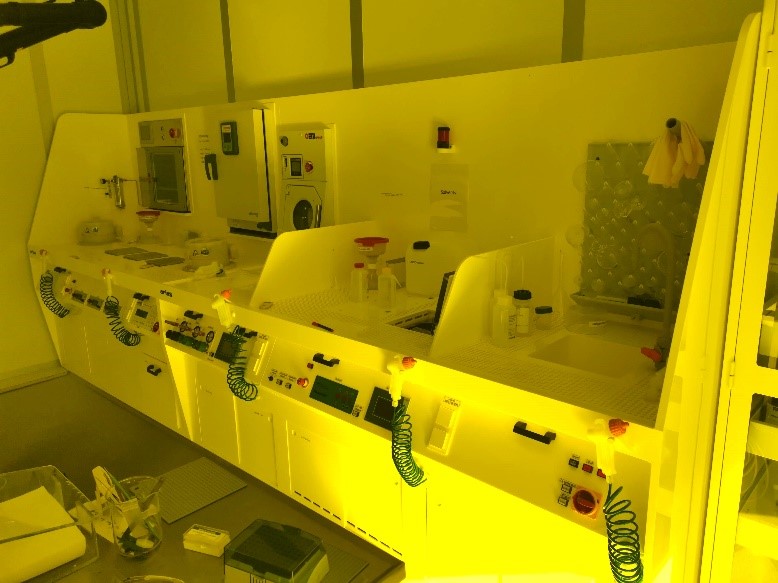Document Responsible: Bjarke Rolighed Jeppesen
Date: 14 June 2021

The purpose of this APV instruction is to ensure that users are aware of the potential dangers that exist when working at the Arias Wet Bench located inside the iNANO cleanroom facility. All users who work at the wet bench should be aware of the potential hazards listed below. The aim of this APV instruction is also to prevent personal injury to maintenance personnel.
The wet bench is a unit specially designed and constructed to serve the photoresist processing needs of the cleanroom at iNANO. Integrated into the wet bench are smaller instruments. Integration allow optimal space usage, high safety, and efficient resist processing. The instrument is equipped with manual resist spin coaters, hot plates and manual development bath for high flexibility. The instruments integrated into the wet bench are:
- one HMDS oven for improved adhesion of resists to sample (see HMDS oven APV)
- two resist spinners for resist coating of wafers
- two hot plates for resist baking after spin coating
- one convection oven for resist baking or dehydration
- one quick dump bath for alkaline developers
- one quick dump DI water bath with integrated water conductivity sensor for rinsing wafers after development
- one section dedicated to lift-off process with temperature controlled ultra-sonication bath
- one acetone bath
- one isopropanol bath
- one quick dump DI water bath.
Chemicals are stored in ventilated cabinets placed below the working surface. Despite the highly integrated functionality for resist processing, the laminar flow in is maintained in the working area and throughout the yellow room. An open wet bench design were adapted because most resists and chemicals for development are relatively harmless. The open wet bench design has the advantage of superior laminar flow and easy access to the many integrated components. However, this open design does not protect the users from splashes. Therefore, for safety reasons only use harmless organic chemicals and weak alkaline developer solutions with low toxicity. Notice: the wet bench is not a fume hood!
In order to avoid exposure to hazardous chemical fumes, chemical fire and chemical explosion, it is important that users follow the instructions given by the super-user. Hot surfaces at the hot plates can cause burns.
A cleanroom suit, protective eyewear and gloves must be worn at the wet bench. The users are required to use an additional layer of acetone resistant gloves when they clean the resist spinners with napkins soaked in acetone or isopropanol.
Before using the wet bench, consult the super-user and read the safety data sheet (sds) for the chemicals used. The design of the wet bench is an open design made for resist processing. Due to the open design, allowed is only chemicals with low reactivity, toxicity and corrosiveness. Forbidden are strongly oxidizing and explosive chemicals. Toxic and non-toxic chemicals are stored in the ventilated space in the wet bench.
Toxic chemicals: Acetone, IPA, ethanol, MIBK, DMSO, PMMA 495/950 in anisole, AZ-series resists, AZ 351/400/726MIF. Sds available in Kiros.
Non toxic chemicals: PDMS.
The drain of the bath with acetone and isopropanol goes into a stainless steel waste container placed in the technical room behind the wet bench. Sensors will inform the user when the waste containers are full.
To avoid possible explosion from chemical vapor, ignited by the wet bench electronics, there is a flow of nitrogen at the electronics. The wet bench shuts down the electronics if sensors detect low nitrogen flow. In case of chemical spills, sensors in the ventilated chemical storage space will detect the spill and warn the user.
Potentially lethal voltages are present on the equipment. To prevent personal injury, ensure the system, circuit or component is isolated from its source of supply prior to undertaking any maintenance or repair of the equipment. Do not rely on control system interlocks or display messages as an indication that it is safe to work on potentially hazardous items.
It is recommended to work in pairs when undertaking work on live systems.